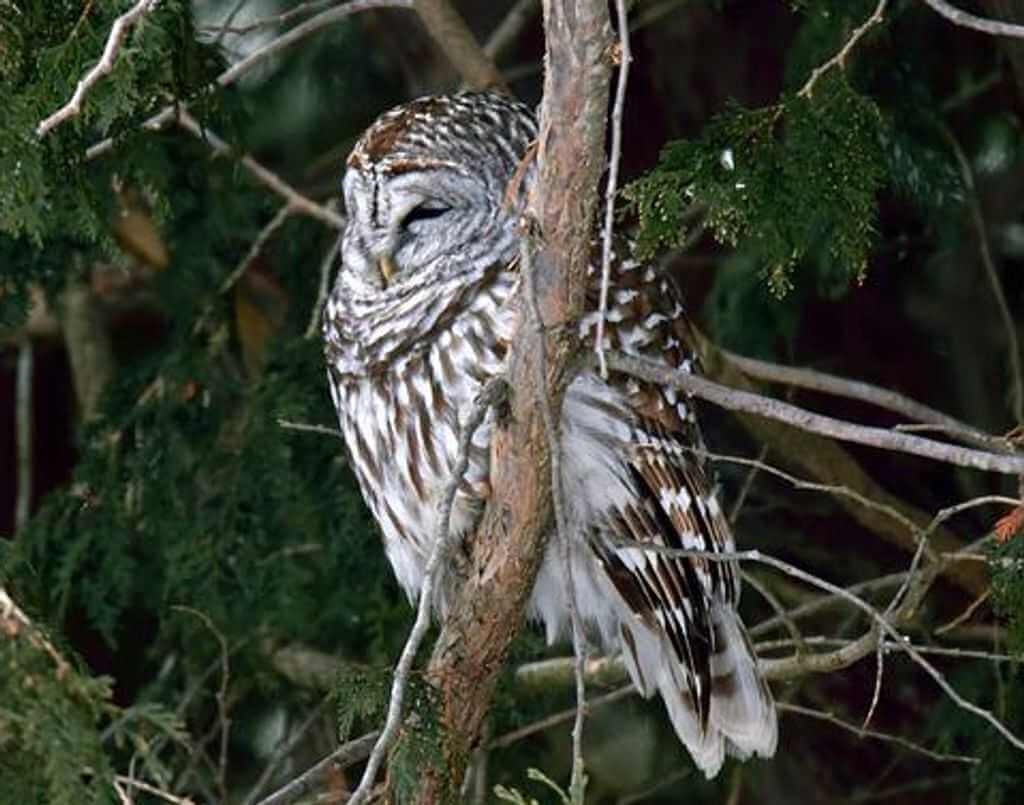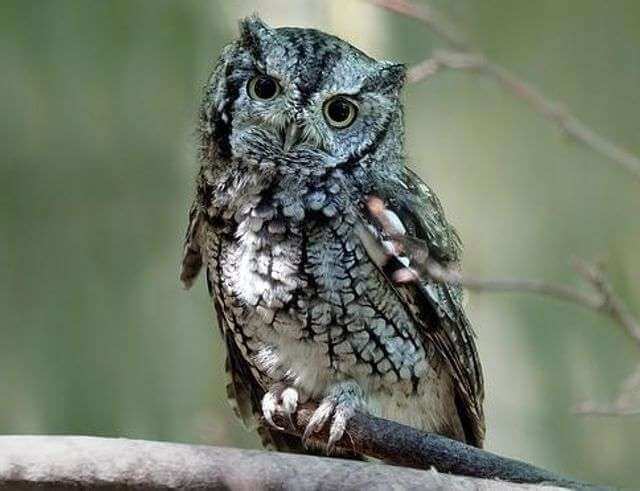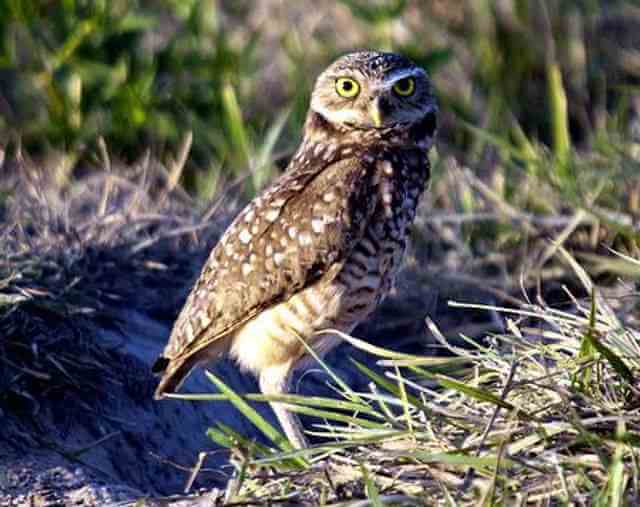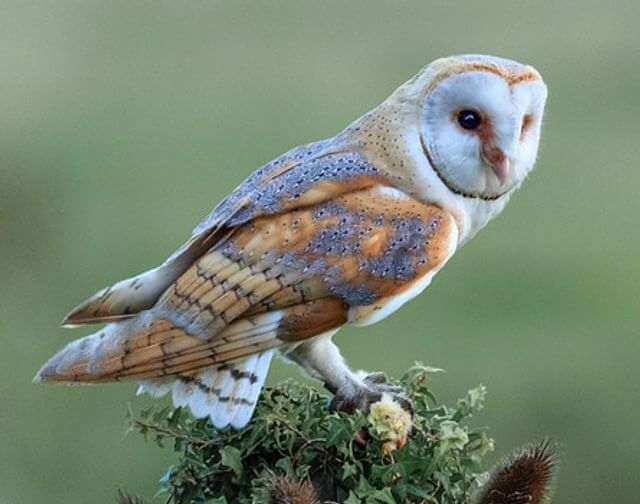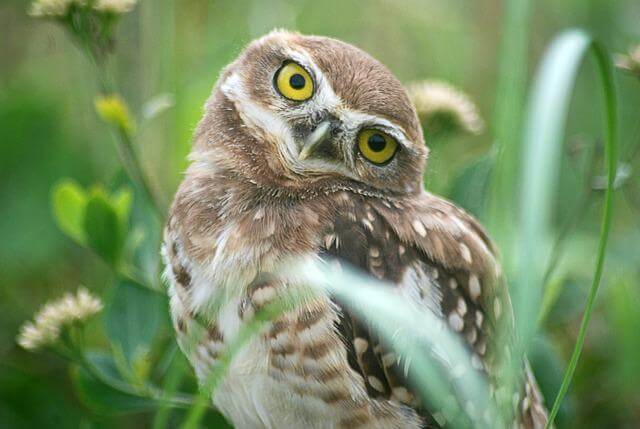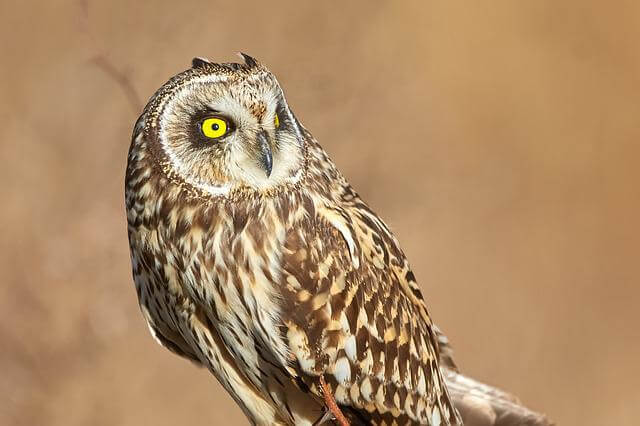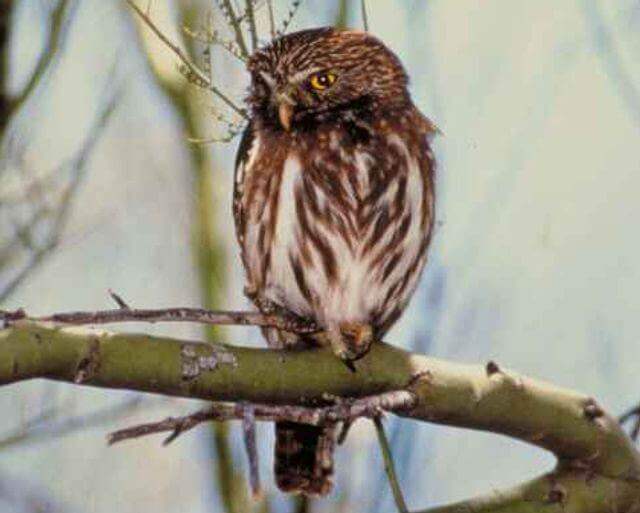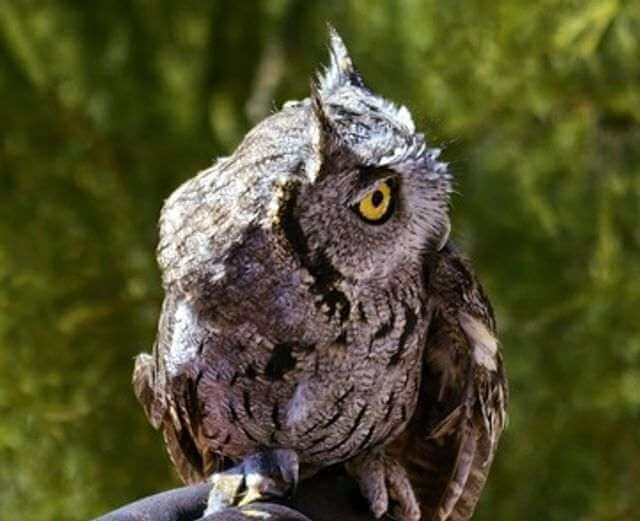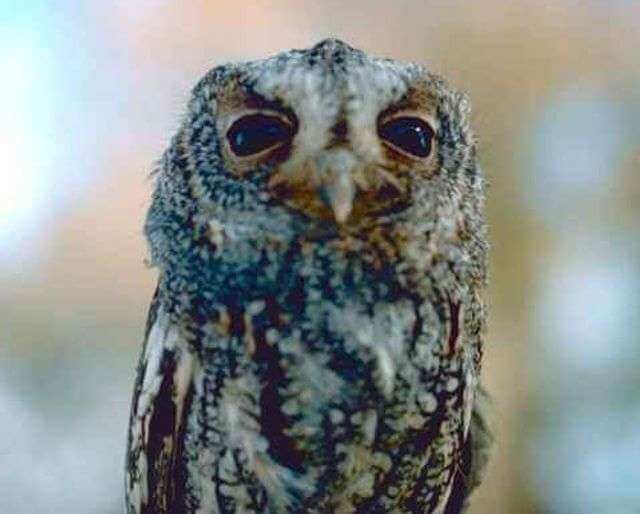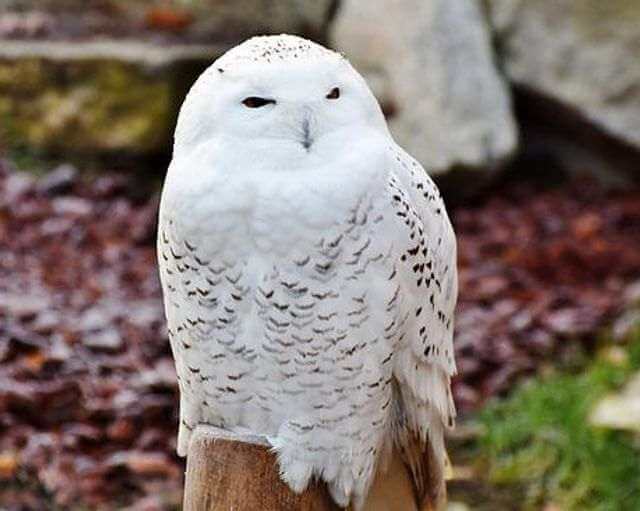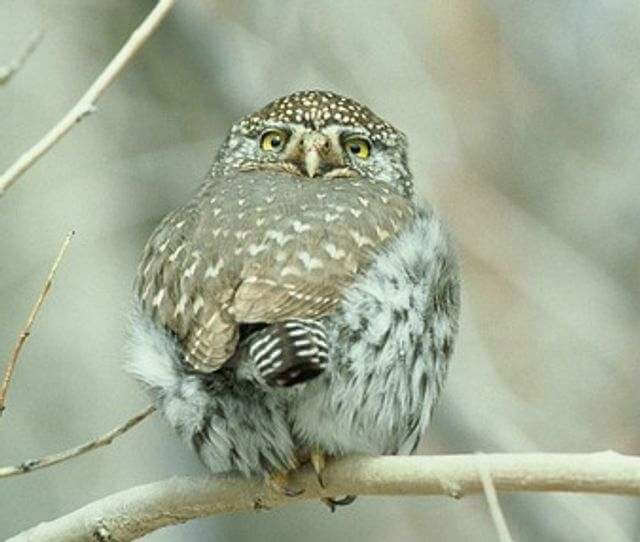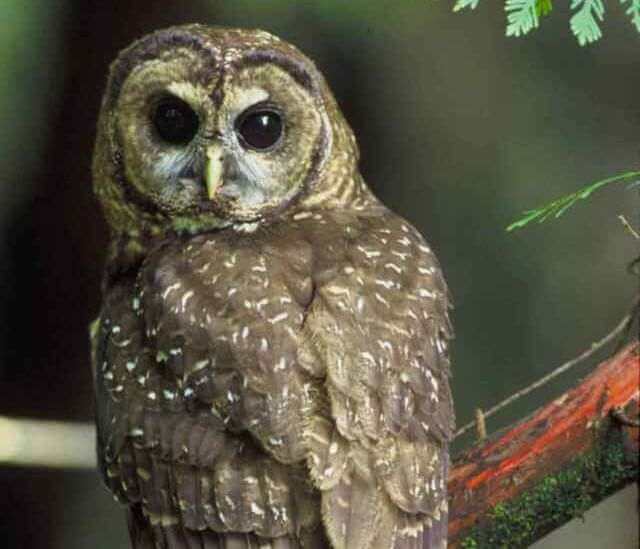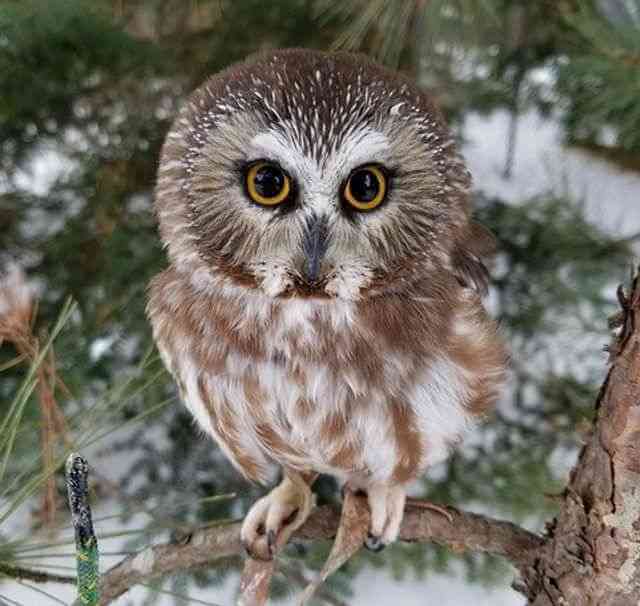Owls are some of the most fascinating and elusive animals in North America. In Texas, there are 17 different types of owls, each with its own unique characteristics and habits.
This article provides a snapshot of each of the 17 owls in Texas, along with their identification tips, maps, sounds, frequency of occurrence, and where they are commonly found.
Table of Contents
- 1 Types of Owls in Texas
- 1.1 Great Horned Owl
- 1.2 Barred Owl
- 1.3 Eastern Screech-Owl
- 1.4 Burrowing Owl
- 1.5 Barn Owl
- 1.6 Elf Owl
- 1.7 Short-eared Owl
- 1.8 Ferruginous Pygmy-Owl
- 1.9 Western Screech-Owl
- 1.10 Long-eared Owl
- 1.11 Flammulated Owl
- 1.12 Snowy Owl
- 1.13 Northern Pygmy-Owl
- 1.14 Spotted Owl
- 1.15 Northern Saw-whet Owl
- 1.16 Mottled Owl
- 1.17 Stygian Owl
- 2 Frequently Asked Questions
- 3 Author
Types of Owls in Texas
Great Horned Owl
- Length: 18.1-24.8 in (46-63 cm)
- Weight: 32.1-88.2 oz. (910-2500 g)
- Wingspan: 39.8-57.1 in (101-145 cm)
- Scientific Name: Bubo virginianus
- Frequency of Occurrence: 2.01% (Statistic by: eBird)
- Where To Find Them: Great horned owls can be found throughout the state, but there are a few areas where they are particularly common. One such area is the Big Thicket National Preserve in Southeast Texas. The preserve is home to a large population of great horned owls, and it’s easy to see them perched in trees or soaring overhead. Another good place to see great horned owls is along the Rio Grande River Valley. The wide open spaces and abundance of prey make this area ideal for these raptors.
- How to Attract: There are several things you can do to attract great horned owls to your property. One thing to consider is providing a roosting area for the owls. This could be in the form of an old tree with a large cavity or an artificial nest box. You can also provide food for the owls by putting out small mammals such as rats or mice. Finally, make sure you keep your property free of clutter so that the owls have a clear view of their surroundings.
General Information: Great Horned Owls are one of the most widespread owl species in the world. They can be found in North America, Central America, South America, Europe, Asia, and Africa. Great Horned Owls inhabit a variety of habitats including forests, grasslands, deserts, and wetlands.
They are apex predators and feed on a variety of prey items including rodents, birds, reptiles, amphibians, and even other owls. Great Horned Owls typically nest in trees, but they will also use cliffs or man-made structures like buildings or bridges.
Related Post: 35 Fun Facts About The Great Horned Owl (Detailed)
Barred Owl
- Length: 16.9-19.7″ in (43-50 cm)
- Weight: 16.6-37.0 oz. (470-1050 g)
- Wingspan: 39.0-43.3″ in (99-110 cm)
- Scientific Name: Strix varia
- Frequency of Occurrence: 1.59%
- Where To Find Them: Some of the best spots to see them are in east Texas near the Sabine National Forest, in the piney woods region of central Texas, and along the Rio Grande Valley.
- How to Attract: Barred Owls prefer mature forests with plenty of large trees for nesting and roosting. They also need a good source of prey, so make sure to provide some areas where mice, rats, or other small mammals can live. A water source is also important, as Barred Owls often drink and bathe in it.
General Information: The barred owl is a large-sized owl that is found in North America and parts of Central America. In the United States, the barred owl ranges from Maine to Florida, and west to Texas. The species inhabits deciduous forests, mixed woodlands, riparian corridors, and evergreen forests.
The diet of the barred owl consists mostly of small rodents such as mice, rats, and voles. The owl will also eat birds, insects, amphibians, reptiles, and fish. Barred owls typically nest in tree cavities but will also use nests made by other animals or take over an old hawk or crow nest.
Eastern Screech-Owl
- Length: 6.3-9.8″ in (16-25 cm)
- Weight: 4.3-8.6 oz. (121-244 g)
- Wingspan: 18.9-24.0″ in (48-61 cm)
- Scientific Name: Megascops asio
- Frequency of Occurrence: 1.23%
- Where To Find Them: One of the best places to see Eastern Screech-Owls in Texas is at Brazos Bend State Park. This park has over five miles of trails that wind through thick forests and wetlands. The owls can be heard calling out to each other at night, and sometimes they can even be seen perched in a tree during the day. Another great place to see these owls is at Fort Worth Nature Center and Refuge.
- How to Attract: Eastern screech owls can be attracted to your backyard by providing them with a nesting box and some food. The best way to provide them with a nesting box is to mount it high up on a tree or pole where it will be out of the reach of predators. To attract eastern screech owls, you can offer them some food items like mice, rats, crickets, mealworms, or bird pellets.
General Information: The Eastern screech-owl is a common owl found in eastern North America. It ranges from southern Canada to Florida, and west to Texas. This owl prefers wooded areas near open spaces, such as parks, golf courses, and agricultural land. The diet of the Eastern screech-owl consists mainly of small mammals, such as mice, rats, and bats.
They will also eat insects, reptiles, amphibians, and occasionally birds. These owls nest in tree cavities or abandoned hawk or raven nests. The female lays 3-5 eggs which are incubated by the male for about 26 days. The young owls fledge about 34 days after hatching.
Burrowing Owl
- Length: 7.5-9.8″ in (19-25 cm)
- Weight: 5.3 oz. (150 g)
- Wingspan: 21.6″ in (55 cm)
- Scientific Name: Athene cunicularia
- Frequency of Occurrence: 0.3808%
- Where To Find Them: There are several spots in Texas where you can see burrowing owls in the wild. One of the best places to see them is at Estero Llano Grande State Park near Weslaco.
- How to Attract: Creating a hospitable habitat for burrowing owls is easy. You can provide a depression in the ground for them to nest in or you can install a nesting box. Be sure to place the box on a pole so that predators cannot reach it. The owls will also need an area where they can hunt rodents and other small prey. Providing a water source is also beneficial. You can attract burrowing owls to your yard by placing out food such as mice, rats, or quail. You can also offer them live insects such as crickets or mealworms.
General Information: The Burrowing Owl is a small-sized owl found in open country and grasslands across much of North and South America. They are well known for their habit of nesting in the burrows of prairie dogs.
The burrowing owl has a range that extends from central Canada down to Argentina, and they can be found in a variety of habitats, including deserts, grasslands, and forests. These owls feed primarily on insects, but will also eat small rodents, reptiles, and amphibians. They typically lay 2-4 eggs in a clutch.
Related Post: Really Cool Burrowing Owl Facts That Will Amaze You!
Barn Owl
- Length: 12.6-15.8″ in (32-40 cm)
- Weight: 14.1-24.7 oz (400-700 g)
- Wingspan: 39.4-49.2″ in (100-125 cm)
- Scientific Name: Tyto alba
- Frequency of Occurrence: 0.3704%
- Where To Find Them: Barn owls can be found in many areas of Texas. One place to spot them is near the Balcones Escarpment where there are a lot of open fields and meadows. During the day, barn owls can often be seen perched on fence posts or tree branches. They are also sometimes seen along roadsides and in open parks.
- How to Attract: People often want to attract barn owls to their property to enjoy their beauty and watch them hunt. There are a few things you can do to make your property more appealing to barn owls. One is to create a nest box for them. You can buy a pre-made box or make your own. The box should be about 18”x18”x24” and have an opening on the side or top for the owl to get in and out. Another way to attract barn owls is to provide a food source for them.
General Information: Barn owls are one of the most widespread owl species. They inhabit temperate and tropical regions of the world. Barn owls are usually found in open country, such as farmland, grasslands, marshes and deserts. They also live in woodlands, suburban areas and even cities.
Barn owls feed on a variety of prey, including small mammals, birds, reptiles and amphibians. They catch their prey by swooping down from a perch or by flying low over the ground. Barn owls build nests out of sticks and other materials in trees, cliffs or barns.
Elf Owl
- Length: 4.7-5.5 in (12-14 cm)
- Weight: 1.2-1.9 oz. (35-55 g)
- Wingspan: 13.0 in (33 cm)
- Scientific Name: Micrathene whitneyi
- Frequency of Occurrence: 0.1578%
- Where To Find Them: The best place to see Elf Owls in Texas is definitely Big Bend National Park. This park has the perfect mix of desert and forest habitats that the owls prefer, and there is always a good chance of seeing them during a visit. Other great spots to see Elf Owls include the Davis Mountains, Guadalupe Mountains, and the Chisos Mountains in Big Bend National Park, as well as the Sam Houston National Forest and Lost Maples State Natural Area.
- How to Attract: First, find a place where there are plenty of insects for the owl to eat. This could be an open meadow, a park, or even your backyard. Second, make sure there is a water source nearby. Owls need water to drink and bathe in. Finally, keep any potential predators away from the area. This includes cats, dogs, and raccoons.
General Information: The elf owl is the smallest owl in North America and is found in the southwestern United States and Mexico. They inhabit open desert, woodland, and riparian habitats. Elf owls are insectivores and eat a variety of insects, including crickets, grasshoppers, beetles, caterpillars, and spiders.
They also eat small lizards, snakes, and rodents. Elf owls nest in tree cavities or cliff crevices. They lay 2-4 eggs which are incubated by both parents for about 26 days. The young owls fledge at about 30 days old.
Short-eared Owl
- Length: 13.4-16.9 in (34-43 cm)
- Weight: 7.3-16.8 oz. (206-475 g)
- Wingspan: 33.5-40.5 in (85-103 cm)
- Scientific Name: Asio flammeus
- Frequency of Occurrence: 0.0950%
- Where To Find Them: One of the best places to see them is the Houston Arboretum and Nature Center. The center is home to many types of animals and birds, including the short-eared owl.
- How to Attract: Short-eared owls can be attracted to your backyard by putting up a nest box and by providing a food source such as a owl pellets or rodents. The best time to put up a nest box is in late winter or early spring before the birds have started nesting. You can also attract these owls by putting out a dish of water and some fresh rodent bait.
General Information: Short-eared owls are common in open habitats such as prairies, meadows, and tundra. They also can be found in agricultural areas, pastures, and marshes. These owls hunt over open ground for small mammals such as rodents and rabbits.
They also eat birds, insects, and other small prey. Short-eared owls nest on the ground in tall grass or other sheltered areas. The female lays 2-7 eggs, which she incubates for about 28 days. The young owls fledge about 42 days after hatching.
Ferruginous Pygmy-Owl
- Length: 6.5-7.0″ in.(16.5-17.8 cm)
- Weight: 1.6-3.8 oz. (46-107g.)
- Wingspan: 14.5-16″ in. (36.8-40.6 cm)
- Scientific Name: Glaucidium brasilianum
- Frequency of Occurrence: 0.0734%
- Where To Find Them: Some good spots to see these owls in Texas include the Davis Mountains, Big Bend National Park, and around San Antonio.
- How to Attract: First, make sure you have a large area of dense vegetation in your yard. Ferruginous pygmy-owls prefer to live in areas with lots of trees and shrubs. They also need a perch from which they can watch for prey. A tall tree or large post is ideal for this. Second, provide a food source for the owls. They will eat small mammals, birds, insects, and reptiles. You can offer them a variety of food by putting out bird feeders, providing water features, and planting insect-rich gardens.
General Information: Ferruginous Pygmy-Owl is a small owl that inhabits open woodlands and agricultural areas in western North America. They are mainly brown in color, with some streaks of white and buff on their underparts. These owls feed mainly on insects, but will also take small mammals, reptiles, and birds.
They nest in tree cavities, typically those made by woodpeckers. Ferruginous Pygmy-Owls are year-round residents in their range, which extends from southern British Columbia in Canada to central California in the United States.
Western Screech-Owl
- Length: 7.5-9.8 in (19-25 cm)
- Weight: 3.5-10.8 oz. (100-305 g)
- Wingspan: 21.6-24.4 in (55-62 cm)
- Scientific Name: Megascops kennicottii
- Frequency of Occurrence: 0.0609%
- Where To Find Them: There are several spots in Texas where the owl can be easily observed. One such spot is the Houston Arboretum and Nature Center, which is home to a large population of Western Screech-Owls. The nature center offers educational programs about the owl and allows visitors to view the birds up close.
- How to Attract: These owls are cavity nesters, meaning they prefer to nest in holes in trees. If you want to attract Western screech-owls to your backyard, you can provide a nesting box for them. You can also make sure to provide a food source for them, such as mice or other small rodents. Western screech-owls are mostly nocturnal, so you will likely see them more at night than during the day.
General Information: The Western Screech-Owl is a small owl that ranges from the Pacific Coast of North America to the Mexican Plateau. This species is easily identified by its characteristic “screeching” call, which is how it got its name. The Western Screech-Owl inhabits a variety of habitats, including open woodlands, riparian areas, and urban areas.
It feeds on a wide variety of prey items, including small mammals, birds, insects, and reptiles. Western Screech-Owls typically nest in tree cavities, but they will also use old hawk or crow nests.
Long-eared Owl
- Length: 13.8-15.8 in (35-40 cm)
- Weight: 7.8-15.3 oz. (220-435 g)
- Wingspan: 35.4-39.4 in (90-100 cm)
- Scientific Name: Asio otus
- Frequency of Occurrence: 0.0256%
- Where To Find Them: In Texas, they can be found in the eastern part of the state, as well as in the Hill Country and along the Rio Grande. They are most commonly seen during winter months, when they migrate to Texas from northern climates. Long-eared Owls can be spotted perched on trees or fence posts, or flying low over open areas. They are often difficult to see because of their camouflage coloring.
- How to Attract: To attract these owls to your backyard, you can provide a safe place for them to perch, such as a large tree or tall pole. You can also put up a nest box or two in an open area near some trees. Providing a food source, such as mice or rats, will also help attract these owls to your backyard.
General Information: The long-eared owl is a medium-sized owl that is found throughout North America, Europe, and Asia. Long-eared owls inhabit open habitats such as forests, meadows, prairies, and wetlands. They are daytime predators that feed on a variety of small mammals such as mice, voles, and rats.
They also eat birds, insects, and reptiles. Long-eared owls nest in tree cavities or on the ground in brushy areas. The female lays 3 to 7 eggs which are incubated for 28 to 32 days. The young owlets fledge at about 5 weeks of age.
Flammulated Owl
- Length: 5.9-6.7 in (15-17 cm)
- Weight: 1.5-2.2 oz. (43-63 g)
- Wingspan: 15.9-16.1 in (40.5-41 cm)
- Scientific Name: Psiloscops flammeolus
- Frequency of Occurrence: 0.0125%
- Where To Find Them: The Flammulated Owl is a small owl that can be found in various areas of Texas. Some spots to see them are the Davis Mountains, the Guadalupe Mountains, and the Franklin Mountains. They prefer higher elevations and can often be seen perched on a tree branch looking for prey. These owls are very active during the day and can be hard to spot, but they are beautiful creatures worth taking the time to look for.
- How to Attract: There are a few things you can do to help attract flammulated owls to your backyard. One is to provide a habitat that mimics their natural environment. This could include a lot of trees and shrubs, as well as a water source. You can also put up owl houses or nesting boxes in the area to give them a place to live. It’s also important to provide food for these owls. They eat mainly insects, but will also take small rodents and other small animals. You can attract them by putting out food like birdseed or mice bait.
General Information: The Flammulated owl is a small owl that ranges from Colorado to southern British Columbia and California. They prefer coniferous forests and often live in ponderosa pine, white fir, and Douglas fir forests. These owls mainly eat small mammals such as mice, voles, and shrews.
They also eat birds, insects, and other small prey. Flammulated owls build their nests in trees cavity or on cliffs. The female lays 3-6 eggs and both parents help incubate the eggs and care for the young chicks.
Snowy Owl
- Length: 20.5-27.9 in (52-71 cm)
- Weight: 56.4-104.1 oz. (1600-2950 g)
- Wingspan: 49.6-57.1 in (126-145 cm)
- Scientific Name: Bubo scandiacus
- Frequency of Occurrence: 0.0087%
- Where To Find Them: There are a few spots in Texas where you can see these beautiful birds. One place is the Austin Wetlands near San Antonio. This area is home to a large population of snowy owls during the winter months. Another spot is Big Bend National Park in West Texas. This park is home to many different types of wildlife, including snowy owls.
- How to Attract: They are not always easy to spot, but there are ways to attract them so you can see these magnificent birds up close. One way to attract a Snowy Owl is by providing them with a place to perch. This could be something as simple as a tall tree or a post. You can also try putting out some food for the owl, such as mice, rabbits, or fish. If you live in an area where Snowy Owls are known to reside, you may want to put up a nest box so they have a place to roost.
General Information: Snowy Owls are the heaviest North American owl and have a wingspan of up to 5 feet. They are mostly white with black spots on their wings and tails. Snowy Owls live in open country near tundra, prairies, marshes, and open woodlands.
They eat small mammals such as rabbits, rats, and mice; also birds, snakes, frogs, and insects. Snowy Owls build their nests on the ground near water or in a tree cavity. Two to four eggs are laid and incubated for about 28 days. The young owls stay with their parents for several months after hatching.
Related Post: 48 Fun Facts About Snowy Owls (with Photos, ID & Info)
Northern Pygmy-Owl
- Length: 6.7-7.5″ in. (17-19 cm)
- Weight: 2.2-2.6 oz. (62-73 g)
- Wingspan: 14.5 – 16″ in.
- Scientific Name: Glaucidium californicum
- Frequency of Occurrence: 0.0012%
- Where To Find Them: In Texas, they are most commonly seen in the eastern part of the state, especially in the piney woods of East Texas and the rolling hills of Central Texas. Pygmy-owls have also been reported in the Davis Mountains and Guadalupe Mountains.
- How to Attract: First, provide a large area with plenty of trees for them to hunt in and nest in. Make sure there are also some areas with dense shrubs and tall grasses, as these owls like to hide in these areas when they’re not hunting. Secondly, offer them a water source like a birdbath or pond. Finally, put up some perches like logs or branches so the owls have somewhere to sit while they watch for prey.
General Information: The Northern Pygmy-Owl is a small owl that is found in the Pacific Northwest region of North America. These owls inhabit coniferous and mixed forests, and can be found at elevations up to 8,000 feet. They are mostly nocturnal, but can also be seen during the day if conditions are favorable.
The Northern Pygmy-Owl feeds on a variety of small prey, including insects, rodents, and birds. They typically nest in tree cavities, but may also use old hawk or crow nests.
Spotted Owl
- Length: 18.5-18.9 in (47-48 cm)
- Weight: 17.6-24.7 oz. (500-700 g)
- Wingspan: 39.8 in (101 cm)
- Scientific Name: Strix occidentalis
- Frequency of Occurrence: 0.0012%
- Where To Find Them: In Texas, spotted owls are most commonly found in the eastern part of the state in the piney woods and bottomland hardwood forests. They have also been seen in the Davis Mountains and Guadalupe Mountains.
- How to Attract: Here are a few tips to help you attract these beautiful birds to your backyard: Provide a safe place for them to nest. This could be a dead tree, an artificial nest box, or even a section of your roof that’s been left untreated. Offer plenty of food and water. Spotted Owls love to eat small mammals, but they’ll also enjoy a variety of other prey items like birds, amphibians, and insects. Make sure there’s always fresh water available too. Keep your yard free of harmful chemicals and pollutants.
General Information: The spotted owl is a species of owl that is found in North America. These owls have a range that extends from British Columbia in the west to Maine in the east. They are also found in parts of California, Nevada and Arizona. The spotted owl’s habitat includes both coniferous and deciduous forests.
They prefer older forests with a large number of trees that are at least 80 years old. The diet of the spotted owl consists mainly of small mammals such as rabbits, hares, squirrels and rodents. They will also eat birds, insects and amphibians. Spotted owls nest in tree cavities or abandoned hawk or eagle nests.
Northern Saw-whet Owl
- Length: 7.1-8.3 in (18-21 cm)
- Weight: 2.3-5.3 oz. (65-151 g)
- Wingspan: 16.5-18.9 in (42-48 cm)
- Scientific Name: Aegolius acadicus
- Frequency of Occurrence: 0.0012%
- Where To Find Them: In Texas, they can be found in areas such as the eastern panhandle, the Big Bend area, and the Davis Mountains. They are most commonly seen in wooded areas and along forest edges. They can also be seen in open fields and meadows near woods or other suitable habitat. They are mostly active at night, but can sometimes be seen during the day.
- How to Attract: Northern Saw-whet Owls can be attracted to your backyard by putting up a nesting box and providing a water source. You can also put up owl decoys to help attract these birds.
General Information: Northern saw-whet owls are one of the smallest owl species in North America. They can be found in the forests of Canada and the United States. In the summer, they live in dense coniferous or mixed woods, and in the winter they can be found in open areas such as pastures, farmland, and suburban neighborhoods.
These owls eat mostly small rodents, but will also take birds, reptiles, and insects. Saw-whet owls build their nests on tree branches, usually close to the trunk. The female lays four to six eggs, and both parents help incubate them and feed the chicks.
Mottled Owl
- Length: 11.4-15″ in. (29-38 cm)
- Weight: 6.0-14.3 oz. (170-405 g)
- Wingspan: 36″ in. (91.4 cm)
- Scientific Name: Ciccaba virgata
- Frequency of Occurrence: 0.0001%
- Where To Find Them: Mottled Owls can be found in many areas of Texas. They prefer to live in wooded areas, near water sources, and open fields. While they can be seen in many parts of the state, some of the best places to spot them are in the eastern part of Texas and along the Rio Grande.
- How to Attract: Mottled Owls can be attracted to your yard by putting up a nest box and placing a few dead trees in your landscape. They also like to live in areas with plenty of understory vegetation and dead trees for hunting. You can also attract these owls by putting out owl pellets, which are the regurgitated bones, fur, and feathers of prey that they have eaten.
General Information: The Mottled Owl is typically found in the eastern half of the United States, though they can be found as far west as California. They prefer a woodland habitat with plenty of trees for nesting and roosting, as well as open areas for hunting.
The diet of the Mottled Owl consists mostly of small mammals such as rodents, but they will also eat birds, reptiles, and amphibians. Breeding occurs from late winter to early summer, and the female lays 2-6 eggs in a tree cavity.
Stygian Owl
- Length: 15-18″ in. (38.1-45.7 cm)
- Weight: 14.1 to 23.8 oz. (400 to 675 g)
- Wingspan: 40.0-46.5″ in. (101.6-118.1 cm)
- Scientific Name: Asio stygius
- Frequency of Occurrence: 0.0001%
- Where To Find Them: The Stygian Owl is a bird that can be found in the state of Texas. There are certain areas or spots where they can be seen. One such spot is in the Big Thicket National Preserve. They can also be found in other areas like Sam Houston National Forest and Caddo Lake State Park.
- How to Attract: There are a few things you can do to attract a Stygian owl to your backyard. One is to install a few light fixtures that emit a low level of light. This will create the type of environment these owls prefer. You can also place some dead trees or other objects in your yard that will give the owl somewhere to perch. Finally, make sure you provide plenty of food for the owl. They typically eat small rodents, so place some traps out in your yard to catch these animals.
General Information: The Stygian owl ranges from the United States of America through north Mexico to northern Argentina. It prefers habitats that include dense forests, but can also be found in open woodlands and scrublands.
The diet of the Stygian owl consists mainly of small mammals, such as rats, bats and rabbits; however, they will also consume birds, reptiles and amphibians. These owls nest in tree cavities or abandoned buildings, laying 2-4 eggs.
Related Post: 20 Most Common Backyard Birds In Texas (Explained)
Frequently Asked Questions
What are the most common owls in Texas?
There are four owl species that are most commonly found in the state of Texas. These owls are the great horned owl, barred owl, Eastern screech-owl, and burrowing owl.
The great horned owl is the most frequent, at 2% frequency of occurrence. The barred owl is next most common, followed by the Eastern screech-owl, and then the burrowing owl.
What is the biggest owl in Texas?
The great horned owl is the biggest owl in Texas. They can grow up to 25 inches tall and have a wingspan of up to 5 feet. They are mostly brown with some white markings, and they have large yellow eyes.
Great horned owls eat a variety of things, including small mammals, birds, reptiles, and amphibians. They live in a variety of habitats, including forests, deserts, and urban areas.
What is the most common owl in North Texas?
The most common owl in North Texas is the great horned owl. The great horned owl has a frequency of occurrence of 2 percent. They are found in habitats such as dense forests, woodlands, and swamps. They are also found in open countrysides, agricultural areas, and suburban areas.
When do screech owls nest in Texas?
Screech owl breeding season in Texas typically runs from February through May. However, there is some variation depending on the location in the state. For example, screech owls in Central Texas may breed a little earlier than those in North Texas.
Nests are typically built a few weeks before eggs are laid and average around 4-6 eggs. Incubation lasts for about 25 days and both parents share incubation duties. The young owlets fledge (leave the nest) at around 8 weeks old.
Can you shoot owls in Texas?
In Texas, the answer to this question is a resounding no. Owls are a protected species in the state and cannot be hunted. There are a variety of owl species found in Texas, including the great horned owl, eastern screech owl, and barred owl. All of these owls are federally protected under the Migratory Bird Treaty Act.
Is it illegal to kill owls in Texas?
In Texas, it is illegal to kill owls. Owls are a protected species by various state and federal laws and cannot be killed. Killing or harming an owl can result in a fine of up to $10,000 or imprisonment for up to one year, or both.
Can you own owls in Texas?
In Texas, you need a license or a permit to own owls. This is because they are protected birds, and it is illegal to hunt them. You also need to have a permit if you want to keep an owl as a pet. The Texas Parks and Wildlife Department issues these permits.

